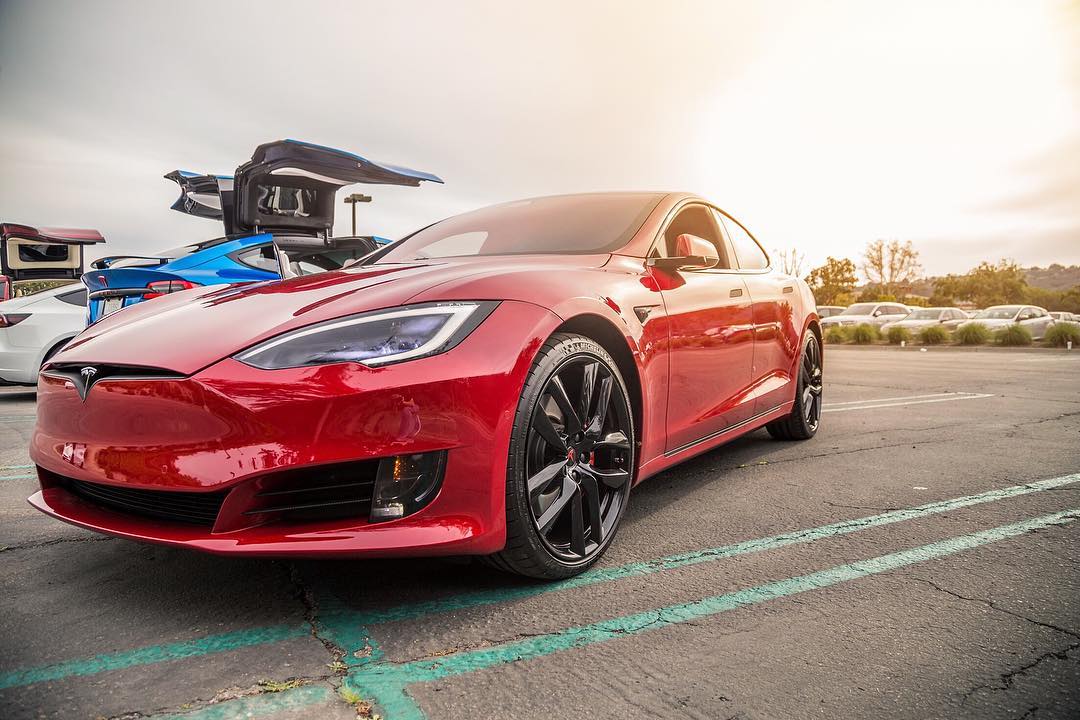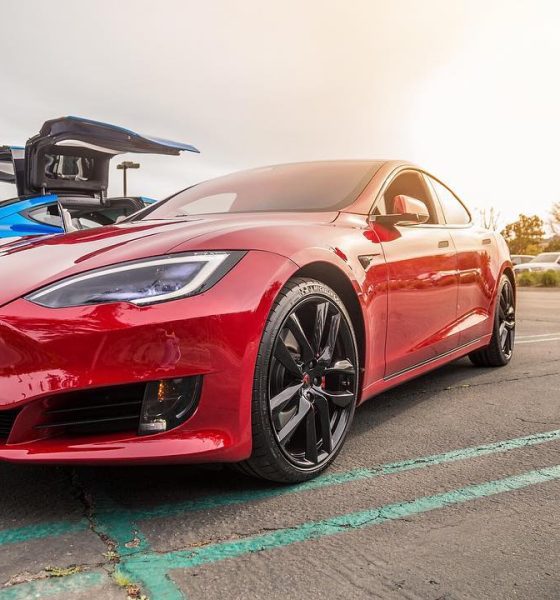

News
Tesla’s Elon Musk gets fired up by competition, reduces Model S price to $69,420
The Tesla Model S is poised to drop to its lowest price yet, with CEO Elon Musk stating that the premium flagship sedan will now start at just $69,420. The Model S price drop, the second one in two days, seemed to be correlated with the announcement of the base model Lucid Air.
Musk’s Twitter post announcing the Model S’ price drop did not specify Lucid Motors by name, though he did state that the “gauntlet has been thrown down,” suggesting that the price adjustment is in response to a competitor. The Tesla CEO seemed to be in light spirits in his announcement, however, with Musk stating that “the prophecy will be fulfilled.”
The gauntlet has been thrown down!
The prophecy will be fulfilled.
Model S price changes to $69,420 tonight!— Elon Musk (@elonmusk) October 14, 2020
Lucid released the price details for the Air sedan’s base variant earlier today. The company announced that the base Air sedan would cost $69,990 after incentives and will be available by early 2022 and can be reserved for $300.
Elon Musk dropped the price of the Model S to a meme-worthy $69,420 not long after Lucid announced the starting price of the base Air. This resulted in the electric car maker reducing the price of its flagship sedan for the second time. The Long Range Plus variant was reduced from a starting price of $74,990 to $71,990 just yesterday.
Introducing the new elemental version of the high-performance, ultra-efficient #LucidAir – post-luxury electric attainable from $69,900* (after US tax credit).
Reserve yours for just $300 and receive 3 years of included Nationwide @ElectrifyAm Charging. https://t.co/6EFqNo10MK pic.twitter.com/IToazgHBcn— Lucid Motors (@LucidMotors) October 14, 2020
As noted by Tesla investor Steve Mark Ryan of YouTube’s Solving the Money Problem channel, Tesla’s ability to drop the price of the Model S “effective immediately” is impressive. This is especially true considering that the base Air is not due until 2022, and it is very likely that Tesla would be able to improve the Model S further by then.
Musk seems to be fired up about the competition, particularly Lucid. Given Lucid and Tesla’s tenuous connection, it may not come as a surprise to some. Lucid CEO Peter Rawlinson is a Tesla alumnus, after all, and he played a role in the development of the Model S. He has also remarked that ultimately, Lucid is “nothing” until the company can actually mass-produce its first vehicle.
@Elonmusk is a savage— Eli Burton (@EliBurton_) October 14, 2020
Regardless of Tesla’s old ties to Lucid’s CEO, however, the recent Model S price drops may have revealed how the EV automaker will react to potential competition in the future. Tesla owner-enthusiast Eli Burton may have put it in the best words, “@Elonmusk is a savage.” Tesla is indeed a savage, and it is one that will not back down from a challenge.
Tesla bears have wondered how the all-electric car maker will react to competition from legacy automakers and new EV companies. Tesla’s latest actions may have just provided some answers.

Elon Musk
Elon Musk and Tesla AI Director share insights after empty driver seat Robotaxi rides
The executives’ unoccupied tests hint at the rapid progress of Tesla’s unsupervised Robotaxi efforts.

Tesla CEO Elon Musk and AI Director Ashok Elluswamy celebrated Christmas Eve by sharing personal experiences with Robotaxi vehicles that had no safety monitor or occupant in the driver’s seat. Musk described the system’s “perfect driving” around Austin, while Elluswamy posted video from the back seat, calling it “an amazing experience.”
The executives’ unoccupied tests hint at the rapid progress of Tesla’s unsupervised Robotaxi efforts.
Elon and Ashok’s firsthand Robotaxi insights
Prior to Musk and the Tesla AI Director’s posts, sightings of unmanned Teslas navigating public roads were widely shared on social media. One such vehicle was spotted in Austin, Texas, which Elon Musk acknowleged by stating that “Testing is underway with no occupants in the car.”
Based on his Christmas Eve post, Musk seemed to have tested an unmanned Tesla himself. “A Tesla with no safety monitor in the car and me sitting in the passenger seat took me all around Austin on Sunday with perfect driving,” Musk wrote in his post.
Elluswamy responded with a 2-minute video showing himself in the rear of an unmanned Tesla. The video featured the vehicle’s empty front seats, as well as its smooth handling through real-world traffic. He captioned his video with the words, “It’s an amazing experience!”
Towards Unsupervised operations
During an xAI Hackathon earlier this month, Elon Musk mentioned that Tesla owed be removing Safety Monitors from its Robotaxis in Austin in just three weeks. “Unsupervised is pretty much solved at this point. So there will be Tesla Robotaxis operating in Austin with no one in them. Not even anyone in the passenger seat in about three weeks,” he said. Musk echoed similar estimates at the 2025 Annual Shareholder Meeting and the Q3 2025 earnings call.
Considering the insights that were posted Musk and Elluswamy, it does appear that Tesla is working hard towards operating its Robotaxis with no safety monitors. This is quite impressive considering that the service was launched just earlier this year.
Elon Musk
Starlink passes 9 million active customers just weeks after hitting 8 million
The milestone highlights the accelerating growth of Starlink, which has now been adding over 20,000 new users per day.

SpaceX’s Starlink satellite internet service has continued its rapid global expansion, surpassing 9 million active customers just weeks after crossing the 8 million mark.
The milestone highlights the accelerating growth of Starlink, which has now been adding over 20,000 new users per day.
9 million customers
In a post on X, SpaceX stated that Starlink now serves over 9 million active users across 155 countries, territories, and markets. The company reached 8 million customers in early November, meaning it added roughly 1 million subscribers in under seven weeks, or about 21,275 new users on average per day.
“Starlink is connecting more than 9M active customers with high-speed internet across 155 countries, territories, and many other markets,” Starlink wrote in a post on its official X account. SpaceX President Gwynne Shotwell also celebrated the milestone on X. “A huge thank you to all of our customers and congrats to the Starlink team for such an incredible product,” she wrote.
That growth rate reflects both rising demand for broadband in underserved regions and Starlink’s expanding satellite constellation, which now includes more than 9,000 low-Earth-orbit satellites designed to deliver high-speed, low-latency internet worldwide.
Starlink’s momentum
Starlink’s momentum has been building up. SpaceX reported 4.6 million Starlink customers in December 2024, followed by 7 million by August 2025, and 8 million customers in November. Independent data also suggests Starlink usage is rising sharply, with Cloudflare reporting that global web traffic from Starlink users more than doubled in 2025, as noted in an Insider report.
Starlink’s momentum is increasingly tied to SpaceX’s broader financial outlook. Elon Musk has said the satellite network is “by far” the company’s largest revenue driver, and reports suggest SpaceX may be positioning itself for an initial public offering as soon as next year, with valuations estimated as high as $1.5 trillion. Musk has also suggested in the past that Starlink could have its own IPO in the future.
News
NVIDIA Director of Robotics: Tesla FSD v14 is the first AI to pass the “Physical Turing Test”
After testing FSD v14, Fan stated that his experience with FSD felt magical at first, but it soon started to feel like a routine.

NVIDIA Director of Robotics Jim Fan has praised Tesla’s Full Self-Driving (Supervised) v14 as the first AI to pass what he described as a “Physical Turing Test.”
After testing FSD v14, Fan stated that his experience with FSD felt magical at first, but it soon started to feel like a routine. And just like smartphones today, removing it now would “actively hurt.”
Jim Fan’s hands-on FSD v14 impressions
Fan, a leading researcher in embodied AI who is currently solving Physical AI at NVIDIA and spearheading the company’s Project GR00T initiative, noted that he actually was late to the Tesla game. He was, however, one of the first to try out FSD v14.
“I was very late to own a Tesla but among the earliest to try out FSD v14. It’s perhaps the first time I experience an AI that passes the Physical Turing Test: after a long day at work, you press a button, lay back, and couldn’t tell if a neural net or a human drove you home,” Fan wrote in a post on X.
Fan added: “Despite knowing exactly how robot learning works, I still find it magical watching the steering wheel turn by itself. First it feels surreal, next it becomes routine. Then, like the smartphone, taking it away actively hurts. This is how humanity gets rewired and glued to god-like technologies.”
The Physical Turing Test
The original Turing Test was conceived by Alan Turing in 1950, and it was aimed at determining if a machine could exhibit behavior that is equivalent to or indistinguishable from a human. By focusing on text-based conversations, the original Turing Test set a high bar for natural language processing and machine learning.
This test has been passed by today’s large language models. However, the capability to converse in a humanlike manner is a completely different challenge from performing real-world problem-solving or physical interactions. Thus, Fan introduced the Physical Turing Test, which challenges AI systems to demonstrate intelligence through physical actions.
Based on Fan’s comments, Tesla has demonstrated these intelligent physical actions with FSD v14. Elon Musk agreed with the NVIDIA executive, stating in a post on X that with FSD v14, “you can sense the sentience maturing.” Musk also praised Tesla AI, calling it the best “real-world AI” today.








